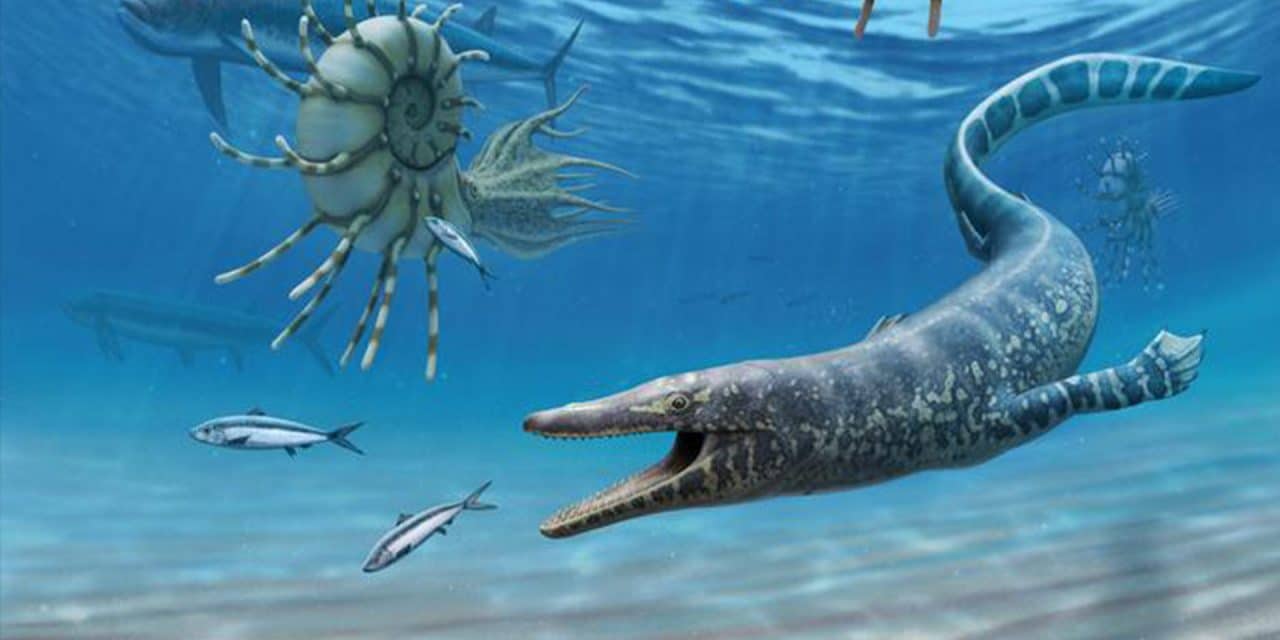UNF and Bureau of Land Management team have discovered an ancient marine reptile fossil that provides ground-breaking evolutionary insight
University of North Florida faculty member Dr Barry Albright is part of a research team led by the Bureau of Land Management (BLM) who have unlocked new evolutionary information following the discovery of a 94-million-year-old mosasaur in the grey shale badlands of the National Park Service Glen Canyon National Recreation Area in southern Utah.
Mosasaurs are fully marine-adapted reptiles that swam the seas while dinosaurs ruled the land.
The journey began nearly 11 years ago as Scott Richardson, a trained volunteer working under Albright, searched for the fossilised remains of creatures that once swam in a vast seaway that covered most of the middle of North America during the Late Cretaceous Period, between 84 and 95 million years ago.
In March 2012, Richardson found numerous small skull fragments and vertebrae of what proved to be an early mosasaur scattered across a broad shale slope.
Albright said: “During the time the Tropic Shale was being deposited, about 94 million years ago, mosasaurs were still very small, primitive, and in the early evolutionary stages of becoming fully marine adapted.
“For these reasons, their fossils are extremely rare and difficult to find.”
- Fossils prove long-necked reptiles decapitated by predators
- New details of ‘enigmatic’ Tully monster fossil revealed
- ‘Weird wonder’ fossils from Wales add to evolutionary puzzle
Dahl’s reptile of the mirage
A joint team from the BLM and National Park Service recovered nearly 50% of the specimen over the course of the next two field seasons, enough to determine its exact identity.
Dr Alan Titus, BLM Paria River District palaeontologist, led a crew of BLM staff and volunteers on the research.
The team included volunteer Steve Dahl who was later honoured in the species name Sarabosaurus dahli, or ‘Dahl’s reptile of the mirage’.
The name alludes to both the ancient seaway in which this animal swam that has long since vanished and the mirages that accompany the region’s extreme summer heat.
Titus said: “Mosasaurs from younger rocks are relatively abundant, but mosasaurs are extremely rare in rocks older than about 90 million years.
“Finding one that preserves so much informative data, especially one of this age, is truly a significant discovery.”
The oldest mosasaurs are small, about three feet long, but they evolved into gigantic lizard-like marine predators that dominated the oceans during the latter part of the dinosaur age.
Their land-dwelling ancestors were similar to the modern Komodo Dragon, but through time their aquatic cousins evolved streamlined bodies, paddle-like fins, and tails that propelled them through the water.
Early forms were more lizard-like in appearance and retained relatively primitive tails and limbs, but Sarabosaurus possessed one important difference; a new way to circulate blood into its brain.
Dr Michael J Polcyn of the University of Utrecht, Netherlands, and Southern Methodist University, Dallas, USA, said: “Sarabosaurus sheds light on long-standing questions regarding the relationship of some early branching mosasaurid species, but also provides new insights into the evolution and antiquity of a novel cranial blood supply seen in a particular group of mosasaurs.”
The study is published in Cretaceous Research.
Image: Artistic depiction of the Sarabosaurus. Credit: Andrey Atuchin provided by the University of North Florida.













